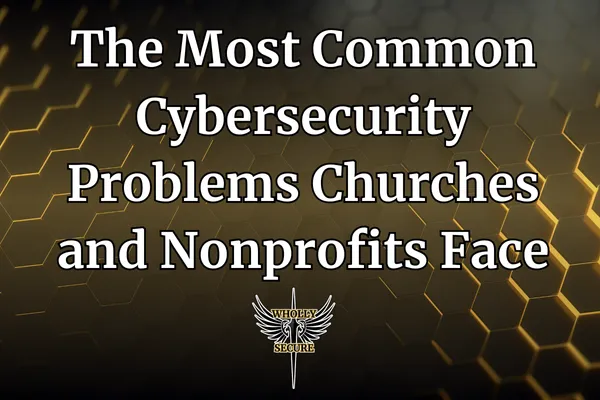
The Most Common Cybersecurity Problems Churches and Nonprofits Face
The Most Common Cybersecurity Problems Churches and Nonprofits Face
Cybersecurity is not just a concern for large corporations. Churches and nonprofits are increasingly targeted by cybercriminals, and many organizations are unprepared. From outdated systems to untrained staff, these vulnerabilities can expose sensitive data and damage trust with your congregation or donors.
In this article, we’ll outline the most common cybersecurity challenges faith-based organizations face and explain how to begin addressing them.
1. No Written Cybersecurity Plan
Many churches assume that their managed IT provider has everything covered. In reality, most do not have a formal cybersecurity plan that defines how information is protected, who is responsible, and what happens in the event of a breach.
Why it matters: Without a written plan, your team may not know how to prevent threats or respond effectively when something goes wrong.
What to do: Start with a basic cybersecurity and compliance assessment. This will give you a baseline view of your current vulnerabilities and help prioritize what needs to be documented.
2. Inadequate Documentation for Compliance
Faith-based organizations are not exempt from laws that protect sensitive information. If your church collects donations, processes payroll, or manages counseling or medical information, you may be required to meet specific state or federal compliance standards.
Why it matters: If your documentation is outdated or incomplete, you may be in violation of legal requirements and at risk of insurance claim denials or audit penalties.
What to do: Conduct a compliance review and begin creating written policies for how data is collected, stored, and accessed. A cybersecurity partner can help translate complex requirements into practical steps.
3. Misplaced Trust in Church Management Systems
Church management systems (ChMS) are excellent tools for organizing data, but they are not designed to be complete cybersecurity solutions. Relying solely on your ChMS to protect sensitive information can leave gaps in your defenses.
Why it matters: These platforms may lack encryption, multi-factor authentication, or proper access controls — leaving donor, member, or volunteer data exposed.
What to do: Evaluate your ChMS as part of a broader security review. Identify what it handles well and where you need to add layers of protection.
4. Lack of Cybersecurity Training for Staff and Volunteers
Even the most advanced security systems can be defeated by human error. Clicking a phishing link, using weak passwords, or sending sensitive data to the wrong person can create serious risk.
Why it matters: A significant percentage of cyber incidents are caused by preventable human mistakes.
What to do: Offer basic cybersecurity awareness training to your staff and volunteers. Topics like safe browsing, email security, and password hygiene can go a long way in reducing risk.
5. No Incident Response Plan
What happens if your systems go down, your donor records are locked by ransomware, or sensitive emails are leaked? Without a plan in place, response time is slower, communication is scattered, and the damage may increase.
Why it matters: The way you respond in the first 24 hours of a cybersecurity incident can determine how costly and public the fallout becomes.
What to do: Work with a security partner to create a simple, documented incident response plan. Make sure it is accessible, actionable, and regularly reviewed.
Final Word
Cybersecurity issues often go unnoticed until something breaks. But for churches and nonprofits, prevention is more affordable and more mission-protecting than recovery. By addressing these common problems, you’re not just securing data — you’re protecting trust.
Ready to find out where your organization stands?
Schedule a Free Discovery Call